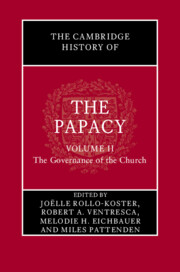Book contents
- The Cambridge History of the Papacy
- The Cambridge History of the Papacy
- Copyright page
- Contents
- Figures
- Tables
- Maps
- Contributors
- General Introduction
- Part I The Pope within the Church
- 1 Vicar of Christ, c.1050–c.1300
- 2 The Pope, the Archdeacon, and the Clergy: A Competition
- 3 From Papal Absolutism to Vatican II
- 4 Vatican II and Its Legacy
- 5 The Synod of Bishops since Vatican II
- Part II The Roman Curia
- Part III Canon Law
- Part IV Finance
- Part V Papal States
- Select Bibliography
- Index
1 - Vicar of Christ, c.1050–c.1300
from Part I - The Pope within the Church
Published online by Cambridge University Press: 28 February 2025
- The Cambridge History of the Papacy
- The Cambridge History of the Papacy
- Copyright page
- Contents
- Figures
- Tables
- Maps
- Contributors
- General Introduction
- Part I The Pope within the Church
- 1 Vicar of Christ, c.1050–c.1300
- 2 The Pope, the Archdeacon, and the Clergy: A Competition
- 3 From Papal Absolutism to Vatican II
- 4 Vatican II and Its Legacy
- 5 The Synod of Bishops since Vatican II
- Part II The Roman Curia
- Part III Canon Law
- Part IV Finance
- Part V Papal States
- Select Bibliography
- Index
Summary
Usage of the title “Vicar of Christ” and the extent of powers implied in it supposedly peaked with Innocent III (r. 1198–1216) and Boniface VIII (r. 1294–1303); the image of popes as monarchic hegemons suited the attempts of legal, political, and constitutional historians to portray the growth of royal power, bureaucracy, and “nations” in competition with other forms of identity. More recently, the medieval papacy has been characterized as responsive and dialogic. Popes’ multiple roles as leader of the universal Church, Bishop of Rome, and ruler of the Papal States meant continual dialogue between center (Rome) and periphery in terms of appeals and petitions presented to the papal curia. Papal opinion and legal rulings mattered precisely because they were sought by regional churches and by secular rulers, and popes relied heavily on the College of Cardinals, judges delegate, and papal legates to represent papal decision-making. While the papal claim to the vicariate of Christ was often challenged by secular powers, this typically occurred in instances where earthly powers sensed that the vicariate of Christ was being wielded to intervene in matters critical to a definition of overlapping and occasionally competing spheres of government.
Keywords
- Type
- Chapter
- Information
- The Cambridge History of the Papacy , pp. 35 - 61Publisher: Cambridge University PressPrint publication year: 2025

